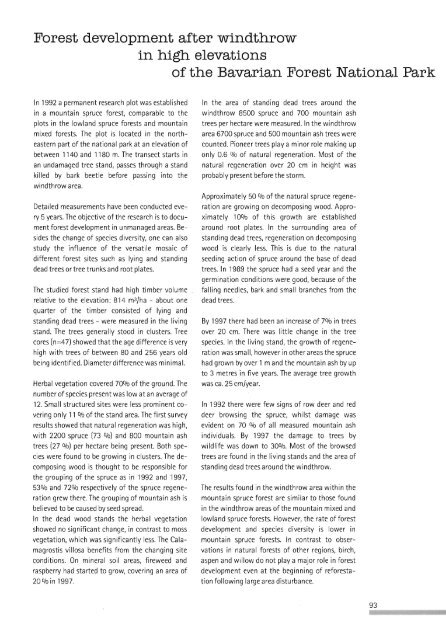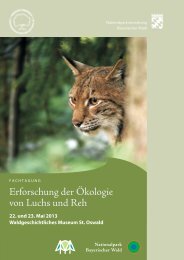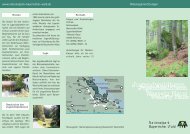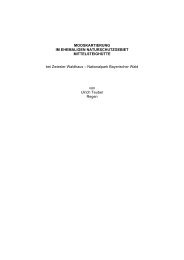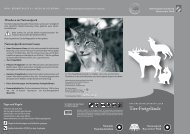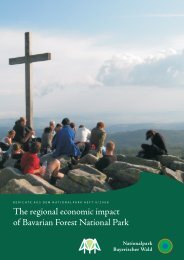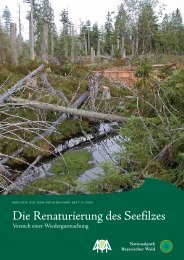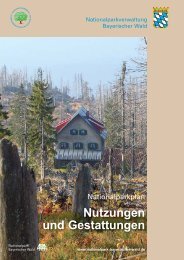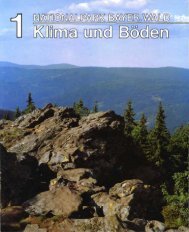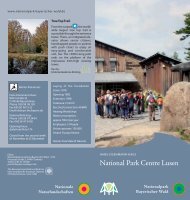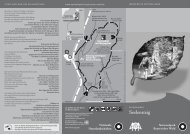Heft 14 - Nationalpark Bayerischer Wald
Heft 14 - Nationalpark Bayerischer Wald
Heft 14 - Nationalpark Bayerischer Wald
Sie wollen auch ein ePaper? Erhöhen Sie die Reichweite Ihrer Titel.
YUMPU macht aus Druck-PDFs automatisch weboptimierte ePaper, die Google liebt.
Forest development after windthrow<br />
in high elevations<br />
of the Bavarian Forest National Park<br />
In 1992 a permanent research plot was established<br />
in a mountain spruce forest, comparable to the<br />
plots in the lowland spruce forests and mountain<br />
mixed forests. The plot is located in the northeastern<br />
part of the national park at an elevation of<br />
between 1<strong>14</strong>0 and 1180 m. The transect starts in<br />
an undamaged tree stand, passes through a stand<br />
killed by bark beetle before passing into the<br />
windthrowarea.<br />
Detailed measurements have been conducted eve-:<br />
ry 5 years. The objective of the research is to document<br />
forest development in unmanaged areas. Besides<br />
the change of species diversity, one can also<br />
study the influence of the versatile mosaic of<br />
different forest sites such as Iying and standing<br />
dead trees or tree trun ks and root plates.<br />
The studied forest stand had high timber volume<br />
relative to the elevation: 8<strong>14</strong> m 3/ha - about one<br />
quarter of the timber consisted of Iying and<br />
standing dead trees - were measured in the living<br />
stand. The trees generally stood in clusters. Tree<br />
cores (n=47) showed that the age difference is very<br />
high with trees of between 80 and 256 years old<br />
being identified. Diameter difference was minimal.<br />
Herbai vegetation covered 70% of the ground. The<br />
number of species present was low at an average of<br />
12. Small structured sites were less prominent covering<br />
only 11 % of the stand area. The first survey<br />
results showed that natural regeneration was high,<br />
with 2200 spruce (73 %) and 800 mountain ash<br />
trees (27 %) per hectare being present. Both species<br />
were found to be growing in clusters. The decomposing<br />
wood is thought to be responsible for<br />
the grouping of the 'spruce as in 1992 and 1997,<br />
53% and 72% respectively of the spruce regeneration<br />
grew there. The grouping of mountain ash is<br />
believed to be caused by seed spread.<br />
In the dead wood stands the herbai vegetation<br />
showed no significant change, in contrast to moss<br />
vegetation, which was significantly less. The Calamagrostis<br />
villosa benefits from the changing site<br />
conditions. On mineral soil areas, fireweed and<br />
raspberry had started to grow, covering an area of<br />
20 % in 1997.<br />
In the area of standing dead trees around the<br />
windthrow 8500 spruce and 700 mountain ash<br />
trees per hectare were measured. In the windthrow<br />
area 6700 spruce and 500 mountain ash trees were<br />
counted. Pioneer trees playa minor role making up<br />
only 0.6 % of natural regeneration. Most of the<br />
natural regeneration over 20 cm in height was<br />
probably present before the storm.<br />
Approximately 50 % of the natural spruce regeneration<br />
are growing on decomposing wood. Approximately<br />
10% of this growth are established<br />
around root plates. In the surrounding area of<br />
standing dead trees, regeneration on decomposing<br />
wood is clearly less. This is due to the natural<br />
seeding action of spruce around the base of dead<br />
trees. In 1989 the spruce had a seed year and the<br />
germination conditions were good, because of the<br />
falling needles, bark and small branches from the<br />
dead trees.<br />
By 1997 there had been an increase of 7% in trees<br />
over 20 cm. There was little change in the tree<br />
species. In the living stand, the growth of regeneration<br />
was smalI, however in other areas the spruce<br />
had grown by over 1 m and the mountain ash by up<br />
to 3 metres in five years. The average tree growth<br />
was ca. 25 cm/year.<br />
In 1992 there were few signs of row deer and red<br />
deer browsing the spruce, whilst damage was<br />
evident on 70 % of all measured mountain ash<br />
individuals. By 1997 the damage to trees by<br />
wildlife was down to 30%. Most of the browsed<br />
trees are found in the living stands and the area of<br />
standing dead trees around the windthrow.<br />
The results found in the windthrow area within the<br />
mountain spruce forest are similar to those found<br />
in the windthrow areas ofthe mountain mixed and<br />
lowland spruce forests. However, the rate of forest<br />
development and species diversity is lower in<br />
mounta in spruce forests. In contrast to observations<br />
in natural forests of other regions, birch,<br />
aspen and willow do not playa major role in forest<br />
development even at the beginning of reforestation<br />
following large area disturbance.<br />
93


